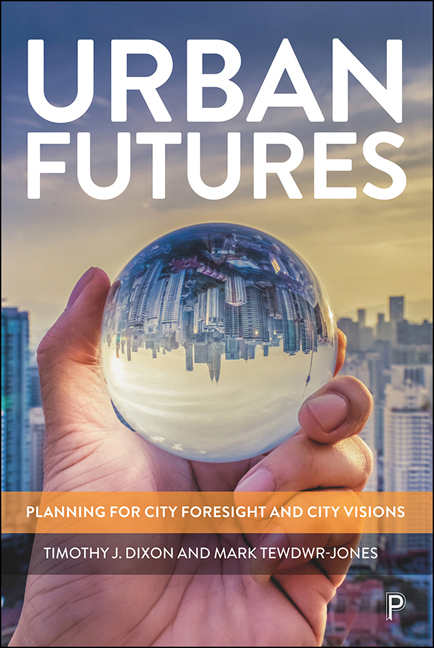Book contents
- Frontmatter
- Contents
- List of figures, tables and boxes
- Acknowledgements
- Foreword
- Preface
- 1 Urban futures: planning for city foresight and city visions
- 2 Cities and integrated urban challenges
- 3 Reimagining the city: views of the future from the past and present
- 4 Planning and governing the future city
- 5 Future narratives for the city: smart and sustainable?
- 6 Theoretical approaches to urban futures
- 7 Using city foresight methods to develop city visions
- 8 Shaping the future: city vision case studies
- 9 The innovative and experimental city
- 10 Visioning and planning the city in an urban age: a reality check
- 11 Conclusions: facing the urban future to 2050 and beyond
- Appendix: selected examples of city visions
- Notes
- References
- Index
8 - Shaping the future: city vision case studies
Published online by Cambridge University Press: 21 December 2021
- Frontmatter
- Contents
- List of figures, tables and boxes
- Acknowledgements
- Foreword
- Preface
- 1 Urban futures: planning for city foresight and city visions
- 2 Cities and integrated urban challenges
- 3 Reimagining the city: views of the future from the past and present
- 4 Planning and governing the future city
- 5 Future narratives for the city: smart and sustainable?
- 6 Theoretical approaches to urban futures
- 7 Using city foresight methods to develop city visions
- 8 Shaping the future: city vision case studies
- 9 The innovative and experimental city
- 10 Visioning and planning the city in an urban age: a reality check
- 11 Conclusions: facing the urban future to 2050 and beyond
- Appendix: selected examples of city visions
- Notes
- References
- Index
Summary
Vision is the art of seeing what is invisible to others.
Jonathan Swift, 1667–1745Introduction
Visions provide us with the means to see the critical issues and challenges that lie ahead, to help fight complacency and to see how things might be different. As Louis Albrechts (2010: 1123) wrote: ‘Visions provide actors with views of the future that can be shared: a clear sense of direction, a mobilisation of energy, and a sense of being engaged in something important’. This is important in the context of transformative change in cities and how we manage and plan for future change. However, visions need to be a shared view of the future and rely on participatory methods to underpin them.
In the last chapter, we saw how the process of city visioning (as part of city foresight) can help us to develop meaningful city visions. In this chapter, we look at some key outputs from these visioning processes. To do this we begin by tracing the evolution of city visions, and the distinctions we should draw between them, and masterplans. We also examine the evolution of city visions over time and look at some specific examples highlighting the linkages between the process of visioning and the development of strategic urban planning. Finally, we look at two very different examples of city visions where foresight has played a major role (Reading 2050 and Newcastle City Futures 2065), and examine what makes a good vision and the opportunities and challenges surrounding the development of city visions.
From masterplans to city visions
As we saw earlier in this book, urban planning's roots lie in a strong tradition of utopic, visionary thinkers who were focused on imagining the ideal city. Even before these thinkers, there had been periods in history when real-world cities had been reimagined – for example Christopher Wren and John Nash in London during the 16th and 17th centuries. These early seeds of thinking spawned the development of large-scale plans, or grand designs, in the 19th and early 20th centuries for large cities around the world, including those for Paris (1853) by Georges-Eugène Haussmann, Barcelona (1855) by Illdefons Cerdà, Chicago (1909) by Daniel Burnham and Vienna (1911) by Otto Koloman Wagner.
- Type
- Chapter
- Information
- Urban FuturesPlanning for City Foresight and City Visions, pp. 153 - 180Publisher: Bristol University PressPrint publication year: 2021



